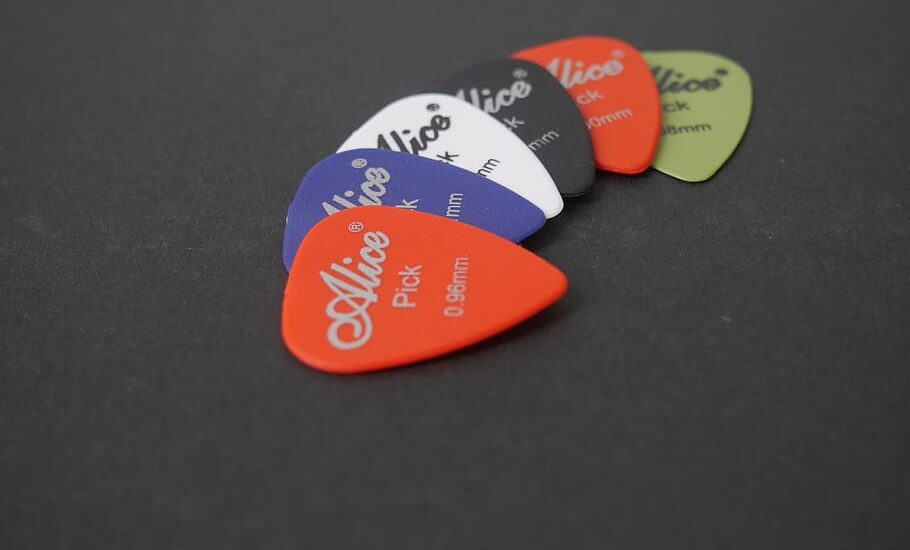If you’re wondering, “why use guitar picks?”, you’re not alone. Many beginners grapple with this question as they embark on their musical journey. This article will take you through the pros, cons, and various techniques associated with using a guitar pick, allowing you to make an informed decision.

Understanding the Basics: Why Use Guitar Picks?
Before you even strum your first chord, one of the pivotal questions that likely cross your mind is why even use a guitar pick? It’s a valid question, and understanding the reasoning behind this simple tool can be crucial for your journey as a musician.
The reasons are more nuanced than they may appear at first glance. Seasoned guitarists often prefer picks for their unique sound texture, increased speed, and reduced finger fatigue. Let’s break down each of these advantages.
Sound Texture
Using your fingers to strum or pluck strings produces a sound that is often described as “warm” or “mellow.” When you switch to using a guitar pick, the texture of the sound becomes brighter and more focused. This sharper tone cuts through the mix better, especially when playing in a band.
Picks are made from a variety of materials—such as plastic, wood, or metal—and come in different thicknesses. Each material and thickness will lend your guitar a different tonal characteristic. For example, a thicker pick usually produces a heavier, more powerful tone, while a thinner pick provides a lighter, more delicate sound.
To truly comprehend these tonal differences, spend a few minutes playing a chord progression first with your fingers and then with a pick. Listen attentively to hear the distinct sound textures.
Greater Speed
While you can achieve impressive speed using fingerstyle techniques, using a pick often allows for greater rapidity with less effort. This becomes particularly noticeable when you’re attempting to master fast-paced genres like rock or bluegrass.
Picks simplify the motion needed to hit the strings, and their thin, rigid form increases the efficiency of your strumming or picking. This results in a more streamlined movement that can significantly improve your speed with consistent practice.
A pick can slide over the strings swiftly, allowing you to focus more on the musical aspect than the mechanics of playing.
Read more guitar topics here – Guitar Questions: Get the Right Answers to Your Burning Questions
Reducing Finger Fatigue
Let’s face it; your fingers can tire out, especially during long practice sessions or performances. Constantly pressing down on steel or nylon strings can result in finger fatigue, limiting your playing time.
A guitar pick acts as a buffer between you and the strings, reducing the physical toll on your fingertips. This allows you to practice or perform for extended periods without as much discomfort or soreness.
Techniques That Benefit from a Pick
Some guitar techniques are not just easier but are designed to be played with a pick. Techniques like alternate picking, where you continuously alternate between downstrokes and upstrokes, or sweep picking, a technique involving a ‘sweeping’ motion across multiple strings, are simplified when using a pick.
Tremolo picking, where one note or a series of notes are played rapidly, is also more straightforward with a pick. These techniques are often essential in genres like metal, rock, and country, making the choice of using a pick crucial if you’re interested in these styles.
How to Choose a Guitar Pick
When it comes to choosing your guitar pick, you’ll find a plethora of options. If you’re a beginner, a medium-thick pick is generally a safe starting point because it offers a balanced combination of flexibility and control.
As you advance in your playing, you’ll naturally develop a preference for specific materials, shapes, and thicknesses that complement your unique style. Don’t hesitate to experiment with a variety of picks to discover what suits you best.
How to Hold a Guitar Pick
Now that you’ve selected your pick, the next important step is to hold it correctly. Place the pick between the thumb and the side of your index finger.
The pointed end should extend outward, away from your thumb, by about half an inch. Hold it securely but not too tightly—a tense grip can hamper your playing. A firm yet relaxed grip will give you the freedom for smooth, flowing movements across the strings.
Final Thoughts: Why Use Guitar Picks?
Now that you understand why using a guitar pick can be advantageous, you’re better equipped to make a decision that suits your playing style. Whether you decide to use a pick or not, remember that practice and dedication are key to mastering any musical instrument.